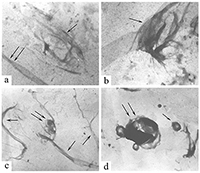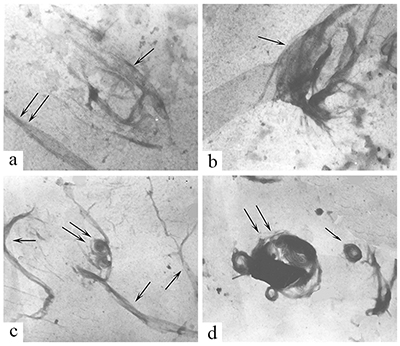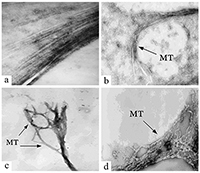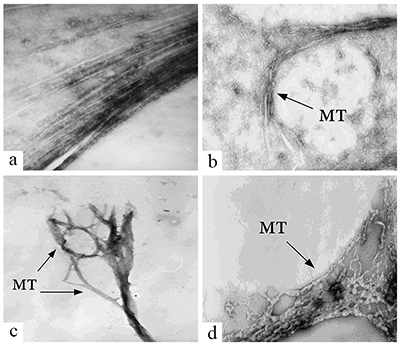The 40th Anniversary of the Institute of Physiologically Active Compounds of the Russian Academy of Sciences
Influence of Metal Ions on Microtubules as a Possible Mechanism of Pathogenesis of Alzheimer's Disease
Institute of Physiologically Active Compounds of the Russian Academy of Sciences, 1 Severny proezd, Moscow region, Chernogolovka, 142432 Russia,*e-mail: pnshevtsov@gmail.com
Key words: Alzheimer's disease; tubulin; microtubules; metal ions; aluminum ions; phosphorylation of microtubular proteins
DOI: 10.18097/BMCRM00050
The article provides an overview of our own results of comparative study of influence of ions of iron, zinc and aluminium on the structure of microtubules from tubulin and microtubules associated proteins of rat brain with data on the structure of microtubules from tubulin and microtubules associated proteins from the brain of patients with Alzheimer's disease (AD). A significant decrease in the amount of soluble tubulin was found in the postmortem brain of AD patients in comparison with the control group in the hippocampus, frontal cortex and substantia nigra, but not in the inferior olive. In vitro polymerization of tubulin and microtubules associated proteins from the brain of AD patients and electron micrographs of microtubules were obtained. The assembly of microtubules from brains of AD patients is disrupted, resulting in defective structures. On the other hand, the study of the influence of Al3+, Fe3+, Zn2+ on the microtubules from rat brains tubulin and microtubules associated proteins assembly and structure has shown that all studied metals are able to reduce the amount of microtubules and induce the assembly of anomal structures. According to the degree of the destructive effect on the microtubules and, accordingly, the possible significance in the pathogenesis of Alzheimer disease, metal ions can be arranged in the following sequence Al3+> Zn2+> Fe3+. Moreover, phosphorylation of tubulin and microtubules associated proteins in the presence of aluminum ions to the greatest extent reflects the phosphorylation of these proteins at AD. Comparison of data on the structure of microtubules after their assembly from brains of AD patients tubulin and microtubules associated proteins from brains of AD patients, and from the brain of rats, but in the presence of metal ions, confirm the conclusion about the possible role of the metals in the AD etiopathogenesis.


|
Figure 1.
Structures of MT assembled in vitro from Tb and MAPs preparations isolated from the brain of AD patients; ×20,000. a) a large loose tangle and MT twisted in pairs (double arrows); b) a large entangled ball;
c) small compact balls; d) compact annular tangles of different size [17]. |


|
Figure 2.
The effect of structures of MT assembled in vitro from Tb and MAPs preparation isolated from the brain of rats: a) - control МТ (without Al3+, Х30000); b) - 10 µM Al3+ (Х20000); c) - 100 µM Al3+ (Х10000);
d) - 250 µM Al3+ (Х20000) [29]. |
ACKNOWLEDGEMENTS
This work was done in frames of the IPAC Research Program Framework 0090-2017-0019 and supported by the Russian Foundation ( grant # 16-03-00079).
REFERENCES
- Reitz, C., Mayeux, R. (2014) Alzheimer disease: Epidemiology, Diagnostic Criteria, Risk Factors and Biomarkers. Biochemical pharmacology, 88(4), 640-651. DOI
- Erkkinen, M.G., Kim, M.O., Geschwind, M.D. (2018) Clinical Neurology and Epidemiology of the Major Neurodegenerative Diseases. Cold Spring Harb Perspect Biol., 2, 10(4). pii: a033118. DOI
- Andrasi, E., Farkas, E., Scheibler, H., Reffy, A., Bezur L. (1995) Al, Zn, Cu, Mn and Fe levels in brain in Alzheimer’s disease. Arch.Gerontol.Geriatr, 21, 89-97, DOI
- Wenstrup, D., William, D.E., William, R.M. (1990) Trace element imbalances in isolated subcellular fractions of Alzheimer’s disease brains. Brain Res., 533, 125-131, DOI
- Lovell, M.A., Robertson, J.D., Teesdale, W.J., Campbell, J.L., Markesbery, W.R. (1998) Copper, iron and zinc in Alzheimer's disease senile plaques. J. Neurol. Sci., 158(1), 47-52, DOI
- Frederickson, C.J., Koh, J.Y., Bush, A.I. (2005) The neurobiology of zinc in health and disease. Nat Rev Neurosci., 6(6), 449-462, DOI
- Mold, M., Umar, D., King, A., Exley, C. (2018) Aluminium in brain tissue in autism. J Trace Elem Med Biol., 46, 76-82. DOI
- Kern, J.K., Geier, D.A., Sykes, L.K., Geier, M.R. (2013) Evidence of neurodegeneration in autism spectrum disorder. Translational Neurodegeneration., 2, 17. DOI
- Yumoto, S., Kakimi, S., Ohsaki, A., Ishikawa, A. (2009) Demonstration of aluminum in amyloid fibers in the cores of senile plaques in the brains of patients with Alzheimer's disease. J Inorg Biochem., 103(11), 1579-1584. DOI
- Perl, D.P., Brody A.R. (1980) Alzheimer’s disease – x-ray spectrometric evidence of aluminium accumulation in neurofibrillary tangle-bearing neurons. Science, 208, 297–299. DOI
- Matsuyama, S.S., Jarvik, L.F. (1989) Hypothesis: microtubules, a key to Alzheimer disease. PNAS USA, 86, 8152-8156. DOI
- Iqbal, K., Grundke-Iqbal, I., Shaikh, S.S., Wisniewski, H.M. (1979) Evidence that Alzheimer neurofibrillary tangles originate from neurotubules. Lancet, 1, 578-580. DOI
- Cash, A.D., Aliev, G., Seidlak, S.L., Nunomura, A., Fujioka, H., Zhu, X., Raina, A.K. (2003) Microtubule reduction in Alzheimer’s disease and aging is independent of filament formation. Amer. J. of Pathology, 162(5), 1623-1627 DOI
- Iqbal, K., Grundke-Iqbal, I., Zaidi T., Merz P.A., Wen G.Y., Shaikh S.S., Wisniewski H.M. (1986) Defective brain microtubule assembly in Alzheimer's disease. Lancet, 2(8504), 421-426. DOI
- O’Farrell, P.H. (1975) High resolutiion two-dimentional electrophoresis of proteins. J.Biol.Chem., 250, 4007-4021.
- Smirnov, A.V., Shevtsov, P.N., Burbaeva, G.Sh. (1991) Two-dimensional electrophoretic analysis of the protein spectrum of human brain structures in schizophrenia and senile dementia of the Alzheimer type. Zh Nevropatol Psikhiatr Im S S Korsakova, 91(10), 34-36.
- Shevtsov, P.N., Shevtsova, E.F., Burbaeva, G.Sh.,Bachurin, S.O. (2006) Disturbed Assembly of Human Cerebral Microtubules in Alzheimer’s Disease. Bull Exp Biol Med, 141(2), 265-268.
- Zavalishin, I.A., Yachno, N.N., Gavrilova, S.I. (2001) Neurodegenerative diseases and aging. A guide for doctors. Moscow, 277-353.
- Hirano, A. (1997) Neurons and astrocytes. In: Textbook of neuropathology 3-rd ed. (Davis R., Robertson D. eds.). Willias & Wilkins. Baltimor, 1-109
- Waldron, K.J., Rutherford, J.C., Ford, D., Robinson, N.J. (2009) Metalloproteins and metal sensing. Nature, 460, 823–830. DOI
- Banci, L., Bertini, I. (2013) Metallomics and the Cell. Springer: Basel, Switzerland. DOI
- Myhre, O., Utkilen, H., Duale, N., Brunborg, G., Hofer, T. (2013) Metal dyshomeostasis and inflammation in Alzheimer’s and Parkinson’s diseases: Possible impact of environmental exposures. Oxid. Med. Cell. Longev., 2013, 2013:726954. DOI
- Wright, R.O., Baccarelli, A. (2007) Metals and neurotoxicology. J. Nutr., 137, 2809–2813. DOI
- Eagle, G.R., Zombola, R.R., Himes, R.H. (1983) Tubulin-Zinc interactions: binding and polymerization studies. Biochemistry, 22(1), 221-228. DOI
- Hesketh, J.E. (1981) Impaired microtubule assembly in brain from zinc-deficient pigs and rats. Intern. J. Biochem., 13(8), 921-926. DOI
- Macdonald, T.L., Humphreys, WG., Martin, R.B. (1987) Promotion tubulin assembly by aluminum ion in vitro. Science, 236, 183-186. DOI
- Schmidt, R., Bohm, K., Vater, W., Unger, E. (1991) Aluminium induced osteomalacia and encephalopathy – an aberration of the tubulin assembly into microtubules (MTs) by Al3+? Progress in Histo-and Cytochemistry, 23, 355-364. DOI
- Wallin, M., Larsson, H., Edstrem, A. (1977) Tubulin sulfhydryl groups and polymerization in vitro: Effects of di- and trivalent cations. Experimental Cell Research., 107, 219-225. DOI
- Shevtsov, P.N., Shevtsova, E.F., Burbaeva, G.Sh. (2016) Effect of Aluminum, Iron, and Zinc Ions on the Assembly of Microtubules from Brain Microtubule Proteins. Bull Exp Biol Med. 161(4), 451-455, DOI
- Shevtsov, P.N., Shevtsova, E.F., Burbaeva, G.Sh. (2008) Effect of tacrine, amiridine,akatinol memantine, and triazolam on phosphorylation, structure, and assembly of microtubules from brain microtubular proteins in Alzheimer diseases. Bull Exp Biol Med., 145(2), 218-222. DOI
- Shevtsov, P.N., Burbaeva, G.Sh. (1999) The influence of aluminum ions on the phosphorylation of tubulin and brain microtubular proteins. Zh Nevrol Psikhiatr Im SS Korsakova, 99(9), 52-53.
- Shevtsov, P.N., Burbaeva, G.Sh. (2001) The effects of aluminum ions on the phosphorylation of tubulin and microtubule proteins in the brain. Neurosci Behav Physiol., 31(2), 183-184. DOI